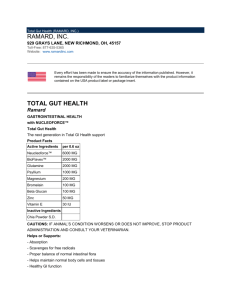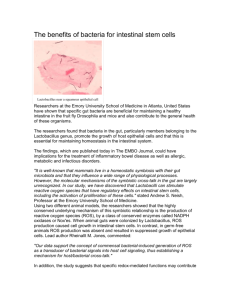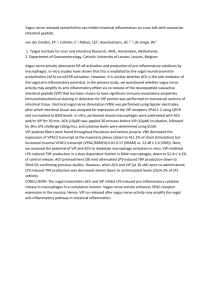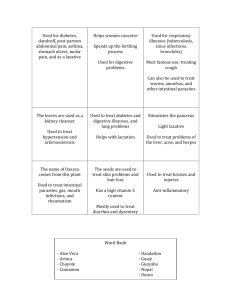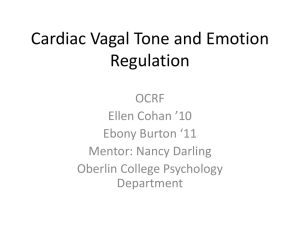Enteric nervous system
advertisement
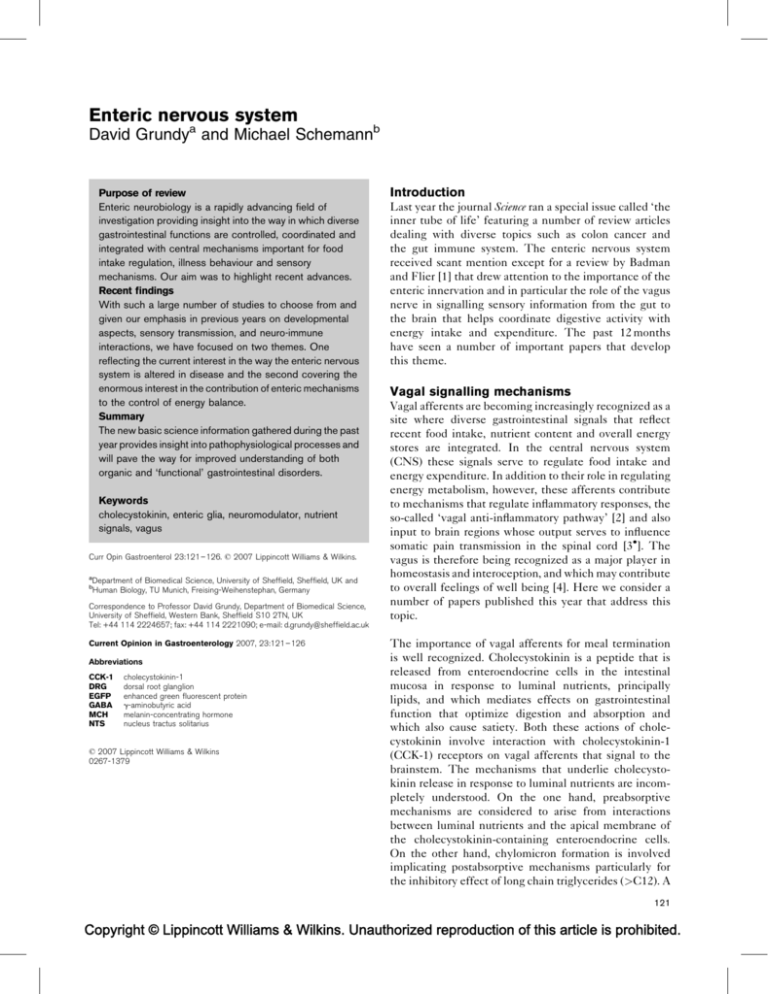
Enteric nervous system David Grundya and Michael Schemannb Purpose of review Enteric neurobiology is a rapidly advancing field of investigation providing insight into the way in which diverse gastrointestinal functions are controlled, coordinated and integrated with central mechanisms important for food intake regulation, illness behaviour and sensory mechanisms. Our aim was to highlight recent advances. Recent findings With such a large number of studies to choose from and given our emphasis in previous years on developmental aspects, sensory transmission, and neuro-immune interactions, we have focused on two themes. One reflecting the current interest in the way the enteric nervous system is altered in disease and the second covering the enormous interest in the contribution of enteric mechanisms to the control of energy balance. Summary The new basic science information gathered during the past year provides insight into pathophysiological processes and will pave the way for improved understanding of both organic and ‘functional’ gastrointestinal disorders. Keywords cholecystokinin, enteric glia, neuromodulator, nutrient signals, vagus Curr Opin Gastroenterol 23:121–126. ß 2007 Lippincott Williams & Wilkins. a Department of Biomedical Science, University of Sheffield, Sheffield, UK and Human Biology, TU Munich, Freising-Weihenstephan, Germany b Correspondence to Professor David Grundy, Department of Biomedical Science, University of Sheffield, Western Bank, Sheffield S10 2TN, UK Tel: +44 114 2224657; fax: +44 114 2221090; e-mail: d.grundy@sheffield.ac.uk Current Opinion in Gastroenterology 2007, 23:121–126 Abbreviations CCK-1 DRG EGFP GABA MCH NTS cholecystokinin-1 dorsal root glanglion enhanced green fluorescent protein g-aminobutyric acid melanin-concentrating hormone nucleus tractus solitarius ß 2007 Lippincott Williams & Wilkins 0267-1379 Introduction Last year the journal Science ran a special issue called ‘the inner tube of life’ featuring a number of review articles dealing with diverse topics such as colon cancer and the gut immune system. The enteric nervous system received scant mention except for a review by Badman and Flier [1] that drew attention to the importance of the enteric innervation and in particular the role of the vagus nerve in signalling sensory information from the gut to the brain that helps coordinate digestive activity with energy intake and expenditure. The past 12 months have seen a number of important papers that develop this theme. Vagal signalling mechanisms Vagal afferents are becoming increasingly recognized as a site where diverse gastrointestinal signals that reflect recent food intake, nutrient content and overall energy stores are integrated. In the central nervous system (CNS) these signals serve to regulate food intake and energy expenditure. In addition to their role in regulating energy metabolism, however, these afferents contribute to mechanisms that regulate inflammatory responses, the so-called ‘vagal anti-inflammatory pathway’ [2] and also input to brain regions whose output serves to influence somatic pain transmission in the spinal cord [3]. The vagus is therefore being recognized as a major player in homeostasis and interoception, and which may contribute to overall feelings of well being [4]. Here we consider a number of papers published this year that address this topic. The importance of vagal afferents for meal termination is well recognized. Cholecystokinin is a peptide that is released from enteroendocrine cells in the intestinal mucosa in response to luminal nutrients, principally lipids, and which mediates effects on gastrointestinal function that optimize digestion and absorption and which also cause satiety. Both these actions of cholecystokinin involve interaction with cholecystokinin-1 (CCK-1) receptors on vagal afferents that signal to the brainstem. The mechanisms that underlie cholecystokinin release in response to luminal nutrients are incompletely understood. On the one hand, preabsorptive mechanisms are considered to arise from interactions between luminal nutrients and the apical membrane of the cholecystokinin-containing enteroendocrine cells. On the other hand, chylomicron formation is involved implicating postabsorptive mechanisms particularly for the inhibitory effect of long chain triglycerides (>C12). A 121 Copyright © Lippincott Williams & Wilkins. Unauthorized reproduction of this article is prohibited. 122 Small intestine recent study has utilized apolipoprotein A-IV knockout mice to examine the role of this chylomicron component in the signalling of intestinal lipid [5]. They found that gastric emptying was faster in the knockout compared with wild-type animals. In addition, meal-stimulated gastric acid secretion was inhibited by intestinal lipid infusion in wild-type but not the knockout animals. Finally, they demonstrated that vagal activation of the nucleus of the solitary tract by intestinal lipid was attenuated in the knockout animals. Neuronal activation induces transcriptional and translational activity of the c-fos oncogene which in turn generates intracellular regulatory proteins, Fos, which can be detected using immunocytochemical methodology. Counting the number of Fos-positive neurones in the nucleus tractus solitarius (NTS) is therefore a measure of vagal activity. These experiments provide a clear demonstration of the importance of lipid absorption and chylomicron formation for vagal signalling of lipid components within ingested meals. It is also clear, however, that this is not the only mechanism involved since the reduction in Fos expression in the NTS was reduced only by about half in the knockout animals. It would be interesting to correlate these effects with cholecystokinin release in order to determine the extent to which pre and postabsorptive mechanisms contribute to nutrient signalling. In this respect, the same group has utilized a CCK-1 receptor knockout mouse to examine the role of vagal afferent mechanisms in lipid-induced modulation of gastric motor and secretory function [6]. Like the apolipoprotein A-IV knockout, the CCK-1 receptor knockout had increased gastric emptying and blunted inhibition of gastric acid secretion following intestinal lipid infusion. Similarly, brainstem Fos activation by intestinal lipid was also reduced by about 50% in the CCK-1 knockout, despite the absence of any response to exogenous cholecystokinin. Thus it is unlikely that CCK-2 receptors contribute to the vagal activation in response to intestinal lipid but that other mechanisms independent of cholecystokinin release are likely involved, possible arising from mealinduced distension or release of other chemical mediators from the intestinal epithelium by preabsorptive or postabsorptive nutrient stimuli. While the studies discussed above have focused on the gastrointestinal consequence of vagal afferent activation by meal-related stimuli, a recent review by Schwartz [7] has considered the consequence for food intake regulation. The integration of vagal and nonvagal mechanisms are discussed, with an important role for the brainstem in assimilating and processing sensory information and, through reciprocal interactions with hypothalamic nuclei and areas of the limbic cortex, influencing food consumption. One important pathway between the NTS and hypothalamus is mediated by neurones that express proopiomelancortin. Proopiomelancortin knockout mice are obese yet little is known about the role of NTS proopiomelancortin neurones in the processing of vagal afferent input from the gut. A recent study [8] has started to address this following development of a transgenic mouse in which proopiomelancortin is tagged with enhanced green fluorescent protein (EGFP). This allows the distribution of EGFP in the subnuclei of the NTS to be determined and targeted in electrophysiological experiments designed to examine their synaptic inputs. Cholecystokinin induced c-fos gene expression in NTS proopiomelancortin EGFP neurones consistent with synaptic input from vagal afferents. Moreover, cholecystokinin was shown in patch clamp experiments to activate these neurones via a presynaptic mechanism to increase glutamate release. Opiates have an opposing action consistent with their orexogenic effect when injected into the NTS. Thus the brainstem melanocortin system has the potential to integrate signals from the periphery via incoming afferents carrying short-term information on satiety with central pathways that can activate appetite. Integration may also occur in the periphery on the terminals of sensory vagal afferents. While a pivotal role for CCK-1 receptors is well established, recent studies have identified a number of other putative humoral agents that are considered to act on CCK-1 receptor expressing vagal neurones. Thus vagal neurones expressing CCK-1 receptors also express receptors for leptin (Ob-R), orexin (OX-R1), ghrelin (GHS-1R) and endocannabinoids (CB1). The ligands for these receptors are released in the periphery during fasting or upon feeding and may therefore influence sensory signalling from the gastrointestinal tract with consequences for both short-term and long-term food intake regulation. A recent study adds another mediator to the list, melanin-concentrating hormone (MCH) [9]. The receptor, MCH-1R, can be detected in both rat and human nodose neurones by both reverse transcriptase PCR and immunocytochemistry. Moreover, over 90% of neurones expressing MCH-1R also express CCK-1 receptors. MCH-1R expression is low in fed animals but high in rats fasted for 24 h. In addition, re-feeding fasted animals resulted in a decline in MCH1R expression but only after a period of 5 h. This effect was mimicked by exogenous cholecystokinin and the effect of re-feeding blocked by pretreatment with the CCK-1R antagonist, lorglumide. This suggests that in addition to the effects of cholecystokinin on short-term food intake regulation, it may have long-term effects that extend beyond the period of a single meal. Another striking finding in this study was the observation that the ligand, MCH, is expressed in the same vagal neurones as its receptor and regulated in a similar way by feeding and fasting. MCH in the hypothalamus is associated with hyperphagia and increased body weight. The increase of MCH and its receptor in vagal neurones Copyright © Lippincott Williams & Wilkins. Unauthorized reproduction of this article is prohibited. Enteric nervous system Grundy and Schemann during fasting may also be linked to increased appetite and thus terminated by food intake following release of cholecystokinin. In other words, changes in orexogenic signalling by the vagus may contribute to the suppression of anorexic signals. In contrast, however, a study examining the effect of obestatin, a recently described anorexogenic peptide isolated from the stomach [10], found no effect on vagal afferent activity or cholecystokininmediated inhibition of food intake or gastric emptying [11]. Quite a different role for cholecystokinin arises from a publication by Luyer et al. [12], one which implicates cholecystokinin in the regulation of inflammation. This study arose out of the identification of vagal efferent mechanisms in the inhibition of the systemic inflammatory response to endotoxin [2]. Activation of this ‘cholinergic antiinflammatory pathway’ resulted in reduced tumour necrosis factor-a levels and blunted nuclear factor kB activation following haemorrhagic shock. The authors reasoned that the mechanisms that enable absorption and utilization of nutrients also represent a defence liability to dietary antigen and commensal bacteria and thus the immune system may be downregulated in response to food intake with a critical role for cholecystokinin in the activation of a vago-vagal antiinflammatory reflex. They demonstrated that rats fed a high-fat diet had a reduced cytokine response and preserved intestinal barrier function with reduced bacterial translocation following haemorrhagic shock and that this effect was lost in vagotomized animals. The combined treatment with CCK-1 and CCK-2 receptor antagonists also prevented the high-fat meal induced protection against haemorrhagic shock. The authors argue that a state of immune hyporesponsiveness occurs upon feeding in order to limit any unwanted response to dietary antigens, bacterial toxins and destructive endogenous lysozymes and so preserve gut barrier function and homeostasis. A genome-wide screen of expression levels of receptors and ion channels expressed by gut projecting nodose ganglion neurones (the cell bodies of vagal afferent neurones) in comparison with sensory neurones in the dorsal root glanglion (DRG) has been performed by Peeters et al. [13]. The expression of CCK-1 receptors by nodose neurones is 15-fold higher than in the DRG, which is perhaps not surprising given the wealth of functional data demonstrating the role of the vagus in cholecystokinin’s action on gut function and satiety, as discussed above. This study, however, identifies many other genes that are differentially expressed and therefore provides a valuable resource for anyone who is interested in ion channels and receptors that underlie sensory signalling in nodose and DRG sensory neurones. The supplementary data accessible online catalogues 123 expression of a variety of ion channels and receptors including potassium channels, calcium channels and g-aminobutyric acid (GABA) receptor. These expression data fit nicely a functional study which examined the inhibition of vagal mechanosensitivity by GABA-B receptor activation using baclofen [14]. This inhibition is associated with a reduction in the triggering of transient lower oesophageal relaxations that lead to gastrooesophageal reflux and has potential as a theurapeutic target for treatment of patients with gastrooesophageal reflux disease. The latest study into this mechanism examined the sensitivity of different subpopulations of vagal afferents supplying the gastrooesophageal mucosa and muscle to baclofen in the absence and presence of agents which blocked certain potassium and calcium channels. The mucosal afferent response to stroking the receptive field was inhibited by baclofen, but this effect was lost when rubidium was added to block the G-protein coupled inward rectifier potassium channel and similarly blocked in the presence of the v-conotoxin GVIA, specific for N-type Ca channels. In contrast, the inhibition of tension receptors by baclofen was unaffected by either of these blockers alone or combined. The data suggest that the inhibitory effect of GABA-B receptor activation is mediated via different transduction pathways in the different subpopulations that supply the ferret oesophagus. Mucosal afferent inhibition is N-type Ca channel and GIRK sensitive while inhibition of tension receptor involves neither. This suggests that downstream signalling from GABA-B receptors may be different in different neuronal populations and therefore subjected to differential pharmacological manipulation. Enteric disorders and disease The past year has seen some important publications that advance our understanding of gut diseases in humans and reveal novel targets to improve symptoms or treat the disease. A very elegant study by Wedel et al. [15] reported on novel smooth muscle markers that reveal abnormalities of the intestinal musculature in severe colorectal motility disorders. While smooth muscle a-actin staining was generally normal, immunoreactivity for smooth muscle myosin heavy chain, histone deacetylase 8 or smoothelin was either absent or focally lacking in Hirschsprung’s disease, idiopathic megacolon and slow-transit constipation. In contrast, diseased specimens showed normal smooth muscle morphology by conventional haematoxylin/eosin and Masson’s trichrome staining. Noteworthy, regardless of the type of the underlying colorectal motility disorder and the pattern of altered immunostaining, intestinal blood vessels and the lamina muscularis mucosae were consistently normally labelled, indicating that such alterations would have been missed by studying mucosal biopsies, even those including submucosal Copyright © Lippincott Williams & Wilkins. Unauthorized reproduction of this article is prohibited. 124 Small intestine layers. This raises the important issue of whether progress in pathogenesis of some gut diseases will require extended histopathology in full thickness biopsies. The relevance of altered expression of smooth muscle markers is apparent in mice lacking smoothelin A. The pathology of these animals is similar to that seen in patients with chronic intestinal pseudoobstruction [16]. Extended histopathology has been shown to be of great value in prediction of recurrence of Crohn’s disease [17]. The presence of myenteric plexitis diagnosed at the time of ileocolonic resection in Crohn’s disease patients was a consistent predictor of recurrence and the degree of myenteric plexitis correlated with the severity of recurrence. A recent review covered the emerging roles of hydrogen sulphide on gut physiology and pathology [18]. Hydrogen sulphide has been suggested as the third gaseous mediator besides nitric oxide and carbon monoxide [19]. It is a neurotransmitter in the CNS and functions as a vasodilator [20,21]. Hydrogen sulphide is generated by endogeneous enzyme systems, mainly cystathionine g-lyase and cystathionine ß-synthase and is produced in amounts that can account for physiological responses [20,21]. In the near future we expect to see a growing number of papers on the effect of hydrogen sulphide in the gut. Hydrogen sulphide is synthesized in enteric neurons and acts as an excitatory neuromodulator in the enteric nervous system [22]. Its role in inflammation, nociception, motility and secretion may reveal novel strategies in treating gut disorders that are associated with increased hydrogen sulphide levels. The source of hydrogen sulphide could be diet, enteric neurons, blood or intestinal microbiota. Dietary factors such as red meat, high protein intake, and alcohol are associated with relapse in ulcerative colitis, possibly mediated via hydrogen sulphide production [23,24]. Ulcerative colitis patients have higher luminal hydrogen sulphide concentrations which may compromise use of endogeneously produced butyrate, a short-chain fatty acid that has been shown to antagonize some ulcerative colitis pathologies. It is tempting to speculate whether one rationale to use probiotics for treatment of inflammatory conditions, including some irritable bowel syndrome entities, may be related to prevention of the negative effects of hydrogen sulphide. The positive effects of butyrate may be due to its direct action on epithelium but also to activation of neural pathways that may be protective by increasing motility. It has been recently shown that in rats, short-chain fatty acids trigger peristaltic reflex activity by release of 5-hydroxytryptamine (5-HT) from mucosal cells and activation of 5-HT4 receptors on sensory calcitonin gene-related peptide-containing nerve terminals [25]. Some effects of butyrate are mediated via G-protein coupled receptors, namely GPR43 and GPR41. In the rat intestine GPR43 receptors are expressed on some enteroendocrine cells and mast cells but not on enterochromaffin cells [26]. Enteric glia receive growing interest which is reflected by the increased number of publications revealing their importance for normal gut function. A series of papers by Neunlist and colleagues described some novel roles for enteric glia. In a transgenic mouse model of glial cell disruption they reported changes in enteric neuronal phenotype, in particular a decreased vasoactive intestinal peptide and substance P expression in the submucous plexus and a decreased nitric oxide synthase with concomitant increases in choline acetyltransferase expression in the myenteric plexus [27]. These changes had a functional correlate in that neurally mediated relaxations were much less in transgenic animals. In addition, transgenic mice showed higher intestinal permeability. In another study the same group [28] was able to show that enteric glia cells have antiproliferative effects involving secretion of transforming growth factor-b1 by glial cells. Taken together, these studies suggest that alterations in glia functions impair the gastrointestinal mucosal barrier system and in concert with enteric nerves may be involved in pathologies such as cancer and inflammatory bowel diseases. Interestingly, and in contradiction to the findings in transgenic animals, disruption of glial cell functions with the gliatoxin fluorocitrate caused reduced small intestinal motility [29]. The reason for this discrepancy remains unknown but one important difference between the two models is the lack of inflammation in the fluorocitrate treated animals whereas the transgenic animals showed CD3 positive T-cell infiltrates in the myenteric plexus. It is important to investigate possibilities to selectively activate or inhibit glial cell functions in the tissue in order to provide evidence that this cell population is a worthwhile drug target. The recent identification of aquaporin 1, dipeptide transporter PEP2 and a2 receptor expression on enteric glia is only a first step in this direction [30–32]. The interaction between the enteric nervous and immune systems remains an important topic and some progress has been achieved to shed some light on the neuro-immune axis in the human gut. Importantly, localization of histamine receptors in human tissue has been studied in detail, although we still do not understand enough about the role of particular histamine receptors in the function of the receptor-expressing enteric neurones. Both histamine H1 and H2 receptors have been localized in the enteric plexus [33]. Although the title and abstract of the paper suggest the absence of H3 receptors, the authors describe in the result section H3 expression in two specimens. There is the possibility that the lack of H3 expression in most specimens may be due to the antibody not cross-reacting with the numerous splice variants of the human H3 receptor. A detailed mapping Copyright © Lippincott Williams & Wilkins. Unauthorized reproduction of this article is prohibited. Enteric nervous system Grundy and Schemann of constitutively expressed cyclooxygenase-2 protein in human myenteric and submucous ganglia [34] should be followed by further studies on the neuromodulatory role of prostaglandins in the human enteric nervous system and their potential as drug targets. Conclusion There have been major advances in our understanding of the enteric nervous system but there is still much that we do not know. What is clear is that with the wealth of talented investigators in the field, great strides in our understanding will continue to be made and in the long term will be reflected in clinical practice. References and recommended reading Papers of particular interest, published within the annual period of review, have been highlighted as: of special interest of outstanding interest Additional references related to this topic can also be found in the Current World Literature section in this issue (pp. 207–208). 1 Badman MK, Flier JS. The gut and energy balance: visceral allies in the obesity wars. Science 2005; 307:1909–1914. 2 Borovikova LV, Ivanova S, Zhang M, et al. Vagus nerve stimulation attenuates the systemic inflammatory response to endotoxin. Nature 2000; 405:458– 462. 3 Sedan O, Sprecher E, Yarnitsky D. Vagal stomach afferents inhibit somatic pain perception. Pain 2005; 113:354–359. This study used gastric distension (rapid drinking) in healthy volunteers to assess the role of gastric vagal afferent activation in heat and mechanical evoked pain perception in human volunteers. They conclude that vagal stomach afferents exert an inhibitory effect on somatic pain perception in humans. 4 Craig AD. Interoception: the sense of the physiological condition of the body. Curr Opin Neurobiol 2003; 13:500–505. 5 Whited KL, Lu D, Tso P, et al. Apolipoprotein A-IV is involved in detection of lipid in the rat intestine. J Physiol 2005; 569:949–958. Investigates the role of chylomicron formation in nutrient signalling from the small intestine using apolipoprotein A-IV knockout mice. Whited KL, Thao D, Lloyd KC, et al. Targeted disruption of the murine CCK1 receptor gene reduces intestinal lipid-induced feedback inhibition of gastric function. Am J Physiol Gastrointest Liver Physiol 2006; 291:G156– G162. Despite a relatively normal phenotype the CCK-1R knockout mouse has impaired intestinal feedback in response to lipid and attenuated vagal input to the CNS. 6 7 Schwartz GJ. Integrative capacity of the caudal brainstem in the control of food intake. Phil Trans R Soc Lond B 2006; 361:1275–1280. Appleyard SM, Bailey TW, Doyle MW, et al. Proopiomelanocortin neurons in nucleus tractus solitarius are activated by visceral afferents: regulation by cholecystokinin and opioids. J Neurosci 2005; 25:3578–3585. Paper demonstrating that proopiomelanocortin neurons in the nucleus tractus solitarius integrate information from the gastrointestinal tract with central pathways involved in energy homeostasis. 8 Burdyga G, Varro A, Dimaline R, et al. Feeding-dependent depression of melanin-concentrating hormone and melanin-concentrating hormone receptor-1 expression in vagal afferent neurones. Neuroscience 2006; 137:1405– 1415. Receptor expression on vagal sensory neurones is regulated by nutrient availability and serves to integrate orexogenic and anorectic signals that potentially contribute to the adaptive response to food deprivation. 9 10 Zhang JV, Ren PG, Avsian-Kretchmer O, et al. Obestatin, a peptide encoded by the ghrelin gene, opposes ghrelin’s effects on food intake. Science 2005; 310:996–999. Two peptide hormones with opposing action in weight regulation (ghrelin and obestatin) are derived from the same proghrelin gene. 11 Gourcerol G, Million M, Adelson DW, et al. Lack of interaction between peripheral injection of CCK and obestatin in the regulation of gastric satiety signalling in rodents. Peptides 2006; 27:2811–2819. In this study obestatin was not found to influence cumulative food intake, gastric motility or vagal afferent activity and had no effect on cholecystokinin-induced satiety signalling. 125 12 Luyer MD, Greve JW, Hadfoune M, et al. Nutritional stimulation of cholecys tokinin receptors inhibits inflammation via the vagus nerve. J Exp Med 2005; 202:1023–1029. The role for cholecystokinin in food intake regulation is well described. This study links nutritional control with neuroimmunologic pathways that contribute to protective mechanisms against dietary antigen and commensal bacteria. 13 Peeters PJ, Aerssens J, de Hoogt R, et al. Molecular profiling of murine sensory neurons in the nodose and dorsal root ganglia labeled from the peritoneal cavity. Physiol Genomics 2006; 24:252–263. Genome-wide expression profile of sensory neurones supplying the gastrointestinal tract. Describes molecular signatures that underlie functional similarities and differences between nodose and dorsal root ganglia. 14 Page AJ, O’Donnell TA, Blackshaw LA. Inhibition of mechanosensitivity in visceral primary afferents by GABAB receptors involves calcium and potassium channels. Neuroscience 2006; 137:627–636. Demonstrates the differential role of N-type calcium channels and G-protein coupled inward rectifier potassium channels in inhibition of vagal mucosal and muscle mechanosensitivity by GABA-B receptor activation with baclofen. 15 Wedel T, Van Eys GJ, Waltregny D, et al. Novel smooth muscle markers reveal abnormalities of the intestinal musculature in severe colorectal motility disorders. Neurogastroenterol Motil 2006; 18:526–538. This study has two important conclusions: first, altered expression of smooth muscle markers reveal novel pathologies of myogenic gut disorders and, second, identification of such alterations required histopathology in full thickness biopsies. 16 Niessen P, Rensen S, van Deursen J, et al. Smoothelin-a is essential for functional intestinal smooth muscle contractility in mice. Gastroenterology 2005; 129:1592–1601. Impaired intestinal transit in smoothelin-A/B knockout mice caused obstruction, starvation, and, ultimately, premature death. The pathology of mice lacking smoothelin-A is reminiscent of that seen in patients with chronic intestinal pseudo-obstruction. 17 Ferrante M, de Hertogh G, Hlavaty T, et al. The value of myenteric plexitis to predict early postoperative Crohn’s disease recurrence. Gastroenterology 2006; 130:1595–1606. This paper scored presence and degree of myenteric plexitis at the time of surgery to find that the presence of myenteric plexitis in proximal margins of ileocolonic resection specimens is predictive of early endoscopic Crohn’s disease recurrence. 18 Fiorucci S, Distrutti E, Cirino G, Wallace JL. The emerging roles of hydrogen sulfide in the gastrointestinal tract and liver. Gastroenterology 2006; 131: 259–271. This review highlights future research topics related to hydrogen sulphide mediated gut functions. 19 Wang R. Two’s company, three’s a crowd: can H2S be the third endogenous gaseous transmitter? FASEB J 2002; 16:1792–1798. 20 Boehning D, Snyder SH. Novel neural modulators. Annu Rev Neurosci 2003; 26:105–131. 21 Abe K, Kimura H. The possible role of hydrogen sulfide as an endogenous neuromodulator. J Neurosci 1996; 16:1066–1071. 22 Schicho R, Krueger D, Zeller F, et al. Hydrogen sulfide is a novel pro-secretory neuromodulator in the guinea-pig and human colon. Gastroenterology 2006; 131:1542–1552. This paper reports on the presence of hydrogen sulphide generating enzymes in the human enteric nervous system and describes hydrogen sulphide as a neuromodulator increasing chloride secretion via activation of extrinsic afferents. 23 Tilg H, Kaser A. Diet and relapsing ulcerative colitis: take off the meat? Gut 2004; 53:1399–1401. 24 Jowett SL, Seal CJ, Pearce MS, et al. Influence of dietary factors on the clinical course of ulcerative colitis: a prospective cohort study. Gut 2004; 53:1479– 1484. 25 Grider JR, Piland BE. The peristaltic reflex induced by short chain fatty acids is mediated by sequential release of 5-HT and neuronal CGRP but not BDNF. Am J Physiol Gastrointest Liver Physiol 2006; 14 September [Epub ahead of print]. A thorough study on short-chain fatty acids evoked neurally mediated muscle reflexes. The study also showed the involvement of 5-HT4 receptors and the potentiation of mucosally evoked muscle reflexes by short-chain fatty acids. 26 Karaki S, Mitsui R, Hayashi H, et al. Short-chain fatty acid receptor, GPR43, is expressed by enteroendocrine cells and mucosal mast cells in rat intestine. Cell Tissue Res 2006; 324:353–360. 27 Aube AC, Cabarrocas J, Bauer J, et al. Changes in enteric neurone phenotype and intestinal functions in a transgenic mouse model of enteric glia disruption. Gut 2006; 55:630–637. The authors used transgenic mice expressing haemagglutinin in glia. Glia disruption was induced by injection of activated haemagglutinin-specific CD8þ T cells. One of the first studies demonstrating that impairment of glia resulted in alteration of neuronal phenotypes. Copyright © Lippincott Williams & Wilkins. Unauthorized reproduction of this article is prohibited. 126 Small intestine 28 Neunlist M, Aubert P, Bonnaud S, et al. Enteric glia inhibits intestinal epithelial cell proliferation partly through a TGF-beta1-dependent pathway. Am J Physiol Gastrointest Liver Physiol 2006; 19 January [Epub ahead of print]. 32 Nasser Y, Ho W, Sharkey KA. Distribution of adrenergic receptors in the enteric nervous system of the guinea pig, mouse, and rat. J Comp Neurol 2006; 495:529–553. 30 Gao H, He C, Fang X, et al. Localization of aquaporin-1 water channel in glial cells of the human peripheral nervous system. Glia 2006; 53:783– 787. 33 Sander LE, Lorentz A, Sellge G, et al. Selective expression of histamine receptors H1R, H2R, and H4R, but not H3R, in the human intestinal tract. Gut 2006; 55:498–504. This is the first comprehensive evaluation of histamine receptor expression in the human gut. The study points to important species-dependent expression and localization of particularly the histamine 3 receptor. It also reports preliminary data showing that the expression profile of histamine receptors is changed in patients with food allergy and irritable bowel syndrome. 31 Ruhl A, Hoppe S, Frey I, et al. Functional expression of the peptide transporter PEPT2 in the mammalian enteric nervous system. J Comp Neurol 2005; 490:1–11. 34 Bernardini N, Colucci R, Mattii L, et al. Constitutive expression of cyclooxygenase-2 in the neuromuscular compartment of normal human colon. Neurogastroenterol Motil 2006; 18:654–662. 29 Nasser Y, Fernandez E, Keenan CM, et al. The role of enteric glia in intestinal physiology: the effects of the gliotoxin fluorocitrate on motor and secretory function. Am J Physiol Gastrointest Liver Physiol 2006; 291:G912– G927. Copyright © Lippincott Williams & Wilkins. Unauthorized reproduction of this article is prohibited.
